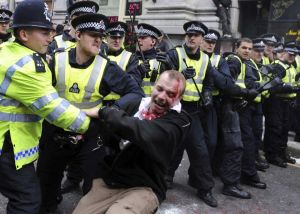 First, a point of clarification. When talking about the “state” in this essay, I am referring to modern, bureaucratic government, whether at the national, regional, or local level, either here or abroad. You know, 21st century-style government.
First, a point of clarification. When talking about the “state” in this essay, I am referring to modern, bureaucratic government, whether at the national, regional, or local level, either here or abroad. You know, 21st century-style government.
One of the things that defines modern states is their effort to create and enforce a monopoly on violence. What that means is, states do not acknowledge the right of any other institution or individual to initiate violence, either intentionally or by reckless accident. Accordingly, individuals are forbidden from engaging in violence unless they are defending themselves from someone else’s unjustified violence. Anyone who initiates violence without state sanction faces the state’s wrath through violent retaliation and/or prosecution.
The monopoly on violence also means that the state grants itself exclusive authority to initiate violence on its own terms. Each state outlines its own reasons for initiating violence. In modern republics such as the United States, those terms are usually restricted to warfare, punishing convicted criminals, and the apprehension of suspected criminals who are behaving violently or threatening to do so. And durin g such instances, only state appointed actors are authorized to initiate that violence: typically military personnel abroad and law enforcement officers at home.
g such instances, only state appointed actors are authorized to initiate that violence: typically military personnel abroad and law enforcement officers at home.
Of course this is just a theoretical monopoly. In reality, no state is anywhere near strong enough to actually monopolize violence. Even an aggressive, repressive totalitarian state cannot manage to keep people from being violent towards each other and occasionally towards the state itself. In any state, unsanctioned violence can be quite pervasive. Here in the United States, for example, there are stunning rates of violence, most of which is never even reported much less prosecuted.
This is important to note. Because if the state cannot effectively monopolize violence despite its best efforts to do so, then it must prioritize violence. The state must develop policies, both formal and informal, about when to initiate violence and which forms of unsanctioned violence to clamp down on. And those policies have very real consequences.
For example, it wasn’t terribly long ago that the state tolerated husbands beating their wives. Even though domestic abuse was already a violation of state laws against battery and assault, cultural prejudices often led the state to turn a blind eye when a husband beat his wife. But by the 1970s, pressure from the women’s rights movement led Americans to reexamine that attitude. As a result, the state is now far more prone to try and prevent domestic violence and prosecute it when it occurs.
attitude. As a result, the state is now far more prone to try and prevent domestic violence and prosecute it when it occurs.
Just as the state prioritizes which unsanctioned acts of violence to prevent and prosecute, it also prioritizes when to initiate violence against its own people. Prior to the Civil Rights movement, state authorities (police) often had free reign to initiate violence against citizens regardless of circumstance, particularly if the person were not white. Frequently acting without consequence, some law enforcement officers inflicted unjustifiable violence at their discretion against African Americans and other minorities. Once again, cultural attitudes have changed in recent decades. And while domestic abuse and to a lesser extent police violence against minorities are still problems, they are are less common than they once were, partly because the state has re-prioritized its attitudes towards those forms of violence.
So when we think about state violence towards Occupy protestors in places like Oakland and Atlanta, we must acknowledge that among the many factors involved is how the state prioritizes violence.
We must also acknowledge those priorities when we think back to Tea Party rallies in which the state did not act violently despite threats of violence from Tea Party member s that took many forms including verbal, written, and the brandishing of guns.
s that took many forms including verbal, written, and the brandishing of guns.
Do not misconstrue. I’m genuinely glad that the state did not act violently against Tea Party demonstrations. Rather, I am pointing out that one of the factors we must consider in explaining state violence against Occupation demonstrations, and a lack of state violence against Tea Party demonstrations, is how the state prioritizes violence.
Of course there are many other factors that must also be considered. For example, in the case of Oakland, there is a recent history of troubled relations between law enforcement and many young people and minorities dating back to 2009 when police officers killed a young, unarmed black man named Oscar Grant, III.
Another factor is that while the Tea Party heartily indulges in anti-state rhetoric, for the most part it has not been willing to directly challenge state authority. Meanwhile, the Occupy movement indulges in anti-corporate rhetoric and mixed rhetoric about the state (some positive, some negative), but it has directly challenged state authority by publicly demonstrating in locales and at hours that the state does not condone.
 There are many, many reasons why the state has and may continue to act violently against Occupy protestors. But among those reason, we must remember to consider how the state interprets its theoretical monopoly on violence and how the state prioritizes its actual use of violence.
There are many, many reasons why the state has and may continue to act violently against Occupy protestors. But among those reason, we must remember to consider how the state interprets its theoretical monopoly on violence and how the state prioritizes its actual use of violence.
And as we take note of it, we must remind the state of it as well.